Wednesday, 19 June, The Opéra Bastille and Sur Mésur
Written 17 July 2019
Backstage tours of the Opera Bastille are only conducted a couple of days a week and only at 5:00 p.m. I hadn't scheduled anything else that day, so we had a quiet day "at home" in the apartment.

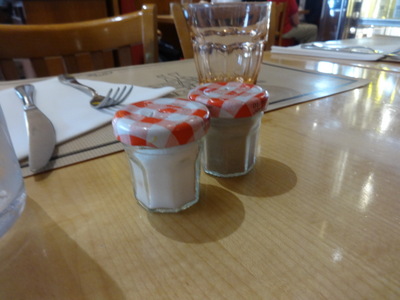 David got up a little before lunch time, and we walked a block or two to the Franc Tireur for lunch. A "franc tireur" (literally "free shooter") is an independent person wo signs up to fight alongside the regular army without actually enlisting in it. Apparently, lots of them took part in the Franco-Prussian war.
David got up a little before lunch time, and we walked a block or two to the Franc Tireur for lunch. A "franc tireur" (literally "free shooter") is an independent person wo signs up to fight alongside the regular army without actually enlisting in it. Apparently, lots of them took part in the Franco-Prussian war.
The place features food and especially meats and cheeses from the "Aubrac" region of France, and they use these great placemats detailing the various cuts of beef and (to my delight) their names in French. I also liked their salt and pepper shakers, which were home made out of miniature Bonne Mamman jam jars with nail holes in the lids.
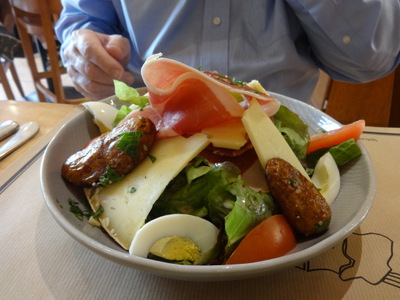
 It was late enough that we could order lunch. David got the salad with raw ham, potatoes (boiled, halved lengthwise, and browned on the cut side on the grill), hard-cooked egg, and Laguiole cheese (from the Aubrac region, of course). Yes, that's the same Laguiole that gives its name to the famous brand of knives marked with a bee on the handle. That's really good cheese—I'll have to watch out for it in the US.
It was late enough that we could order lunch. David got the salad with raw ham, potatoes (boiled, halved lengthwise, and browned on the cut side on the grill), hard-cooked egg, and Laguiole cheese (from the Aubrac region, of course). Yes, that's the same Laguiole that gives its name to the famous brand of knives marked with a bee on the handle. That's really good cheese—I'll have to watch out for it in the US.
I had an omelet with mushrooms.
Then back to the apartment for a while to read and to work on this diary. It's a straight shot on the metro from our nearest stop (Argentine) to Bastille on the #1 line, and fortunately the evening's restaurant was also on that line. The tour was supposed to end at 6:30 p.m., our reservations were at 8:00 p.m., and the time in between would be rush hour, so before setting off for the tour, we dressed for our dinner that evening so that we could just hop on the Metro, come back about halfway, and go straight to the restaurant.
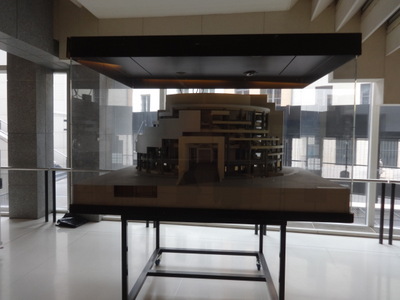
 The Bastille Opera house celebrated its 30th anniversary this month. It was built as a replacement for and improvement on the old red-plush-and-gold-leaf "Palais Garnier" opera house in the center of the city, and as such it has been a huge success. Performers and production staff alike love it—it's clean, modern, convenient, well appointed, well thought out, self-contained, and above all big enough. It is, in fact, huge. Nearly a thousand people work there.
The Bastille Opera house celebrated its 30th anniversary this month. It was built as a replacement for and improvement on the old red-plush-and-gold-leaf "Palais Garnier" opera house in the center of the city, and as such it has been a huge success. Performers and production staff alike love it—it's clean, modern, convenient, well appointed, well thought out, self-contained, and above all big enough. It is, in fact, huge. Nearly a thousand people work there.
At the left here is a model of the building as seen from the Place de la Bastille, and at the right is the main auditorium. We've been to one performance there, years ago with niece Julia, then a budding (and now a professional) operatic soprano, and we sat in the first or second balcony, the white areas cantilevered out over the main floor. The main auditorium is the largest single room in the building, but it occupies only 5% of the volume.
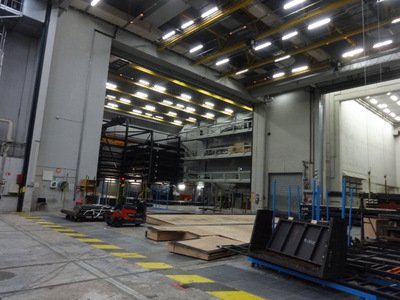
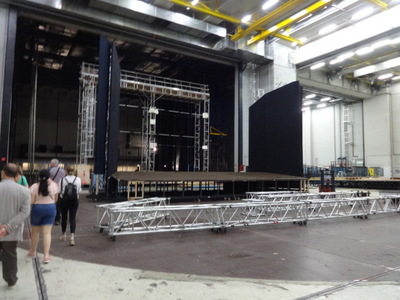 Our tour started on floor –6, looking down into floor –7, all far below street level, and worked its way up gradually through the building to at least the 5th floor above ground. Fortunately, there are escalators, even backstage.
Our tour started on floor –6, looking down into floor –7, all far below street level, and worked its way up gradually through the building to at least the 5th floor above ground. Fortunately, there are escalators, even backstage.
Our guide was throwing out numbers faster than I could catch and record them, but I think he said the place has 300 interior doors and 36 km of corridors. The "coulisses" (usually translated "wings" but actually including all backstage areas) are the largest in the world. The floor space in the building, all added up, rivals that of the Louvre! In addition to all the doors for people, the place is all divided up by automatic fire doors that slam shut in the event of fire. Firemen are actually on duty at the opera round the clock, just in case.
The stage is 330 m by 25 m, and its backstage area is the same size, behind that is the back-backstage, which is again the same size. Off to one side of the backstage area is yet another full-size stage area for rehearsals, and an enormous sound-proof fire door can be lowered so that a full-scale on-stage rehearsal of one opera can be held there while another is being performed on the main stage, just yards away, and the audience is none the wiser.
The scenery elevator is 400 square meters and 1.5 m thick and can lift 300 tonnes.
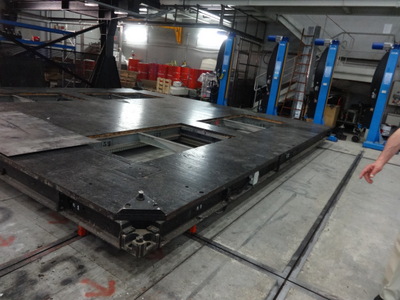
 Scenery is moved around back stage on "chariots" (not as martial as it sounds; shopping carts are also "chariots"), sliding flatbed affairs that run on rails set into the floor. Eight or nine of them linked together just fit the stage. At the left you can see the rails the black chariot rides on. They form a right-angled grid so that the chariots can change direction, and a giant turntable in the center of the backstage area works like a railyard roundhouse to allow them to rotate. An entire stage set can be set up on chariots backstage, and one person can move it, silently, from there onto the stage in 4 minutes.
Scenery is moved around back stage on "chariots" (not as martial as it sounds; shopping carts are also "chariots"), sliding flatbed affairs that run on rails set into the floor. Eight or nine of them linked together just fit the stage. At the left you can see the rails the black chariot rides on. They form a right-angled grid so that the chariots can change direction, and a giant turntable in the center of the backstage area works like a railyard roundhouse to allow them to rotate. An entire stage set can be set up on chariots backstage, and one person can move it, silently, from there onto the stage in 4 minutes.
Operas are always performed in rotating repertory, because no human voice can sing a major operatic role several nights in a row without damage, so the coulisses allow space for the complete sets of five different operas, which can be changed out as needed without having to be broken down and set up again.
The bells (and large gong) in the right-hand photo were set up just offstage where they could be played for one of the operas currently being performed. A video set-up allows the bell ringer to see the conductor in the orchestra pit.

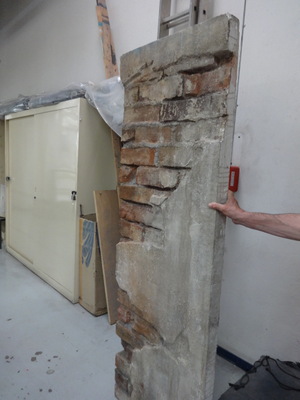 The Bastille Opera makes all its own sets, costumes, and scenery as well as those for the Opéra Garnier, which is now mainly dedicated to dance. It has 8000 square meters of scenery construction space, employing 120 people. The wood shop has table saws big enough to slice up a house.
The Bastille Opera makes all its own sets, costumes, and scenery as well as those for the Opéra Garnier, which is now mainly dedicated to dance. It has 8000 square meters of scenery construction space, employing 120 people. The wood shop has table saws big enough to slice up a house.
At the left is a view down into one of the scenery studios. At the right is a section of brick wall produced there that, the guide revealed, is actually made of styrofoam.
Thirty people people sew the costumes, to measure for the performers, and a wig studio makes, styles, and cares for all the wigs needed. Engineering and construction start a year before every production.
For the production of large painted flats, a guy stands on a high platform and pantographs the designer's drawing of the scenery onto a huge canvas spread on the floor below him. That is, he traces the drawing on an ordinary piece of paper, and a mechanical linkage then moves a little drawing arm over the canvas, reproducing his movements. The canvas is then stood upright and the drawing is painted.
When an opera goes out of active performance but is retained in the opera's repertory, the scenery is packed into shipping containers right back stage, then transferred out through an indoor loading dock and trucked off to the scene-storage facility, 80 km away.
Needless to say, I was impressed.
After the tour, we made our way back to the Bastille metro station (which is on a sort of balcony over the Basin de l'Arsenal and is graced by a wonderful tile mosaic of the storming of the Bastille) and took the #1 line back to Concorde, from which we walked to our restaurant of the evening, which is located in the Mandarin Oriental hotel.
We were early again, of course, but we could tell from the start that the Mandarin Oriental was not quite the class act the Hyatt Place Vendôme was. For example, we strolled in, explored the lobby, scoped out the art on display (featuring large numbers of small metal butterflies), and settled in a seating alcove near the bar without ever being intercepted by anybody. In the high-class joints, you never get to explore the lobby—someone is always right there, greeting you cheerfully, and, in the politest way possible of course, asking your business in the place. We weren't worried about the lack of attention—it was a chance to kill a little more time before having to order a drink.
Eventually, a staff member asked whether we were being helped and sent over a bar waiter. David had his usual glass of champagne and I my usual split of Evian, and they brought us the usual little dishes of olives and, in this case, wasabi peas and almonds.
Eventually, at the appointed hour, we were show into the restaurant, which had a rather strange decor. The tables were arranged in a square around a central atrium, which was open to the sky but glassed in from the dining room. In the center of the atrium was suspended a large luminous green hula hoop from which dripped permanently installed clear plastic drips. It had started to rain, so real drips were also dripping off it, and it took me a while to be sure that some of them were fake.
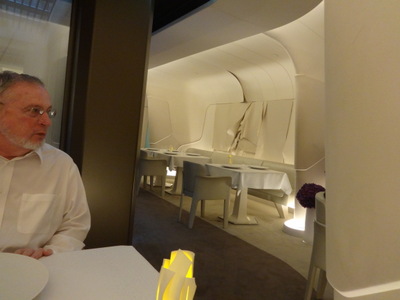
 The area in which the tables were arranged was entirely upholstered in padded canvas, which had, in some spots, been artfully pulled out as though it were coming loose. You can see it in the photo at the left. The gray area behind David's head is the glass of the atrium, fogged up with the rain. The glowing object on the table is our tea light, which I think was intended to evoke the flapping-canvas theme of the banquettes.
The area in which the tables were arranged was entirely upholstered in padded canvas, which had, in some spots, been artfully pulled out as though it were coming loose. You can see it in the photo at the left. The gray area behind David's head is the glass of the atrium, fogged up with the rain. The glowing object on the table is our tea light, which I think was intended to evoke the flapping-canvas theme of the banquettes.
The black conical object in the right-hand photo is our bottle of water. To pour from it, the waiter lifted off the top third of the cone. I have no idea whether we were drinking decanted Evian, filtered water, or as the French say, just "Château Municipale."
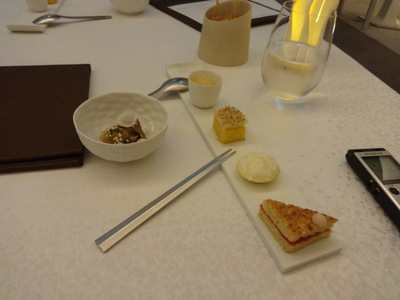
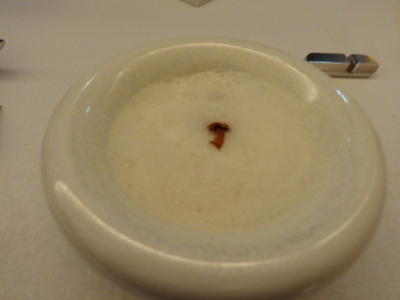 We ordered the six-course tasting menu, which we got to choose from the items on the rather short menu. The chef, it turns out, is fond of trompe l'oeil. At the left is our amuse-bouche, designed to resemble mignardises. The triangle of "cake" with red filling is actually a sandwich of rhubarb between slices of cauiflower "bread"; the tartlet is mashed potato with panko sprinkled on top; the "lemon tart" is yellow and white polenta with hazelnuts; and the tall cup holds leeks vinaigrette with a little shedded wheat on top. In the bowl was (I think) a salad of Swiss chard stems with a little disk of daikon and sesame seeds.
We ordered the six-course tasting menu, which we got to choose from the items on the rather short menu. The chef, it turns out, is fond of trompe l'oeil. At the left is our amuse-bouche, designed to resemble mignardises. The triangle of "cake" with red filling is actually a sandwich of rhubarb between slices of cauiflower "bread"; the tartlet is mashed potato with panko sprinkled on top; the "lemon tart" is yellow and white polenta with hazelnuts; and the tall cup holds leeks vinaigrette with a little shedded wheat on top. In the bowl was (I think) a salad of Swiss chard stems with a little disk of daikon and sesame seeds.
The first real course was "risotto" of soy bean sprouts with an oyster and little chanterelles. That's a tiny chanterelle floating on the foamy surface. The "risotto" is in quotes because no rice was involved. It was a cold soup that included a lot of soy bean sprouts diced up to the size of rice. Pretty good, by why bill it as risotto?
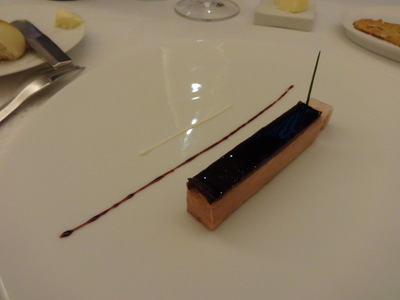
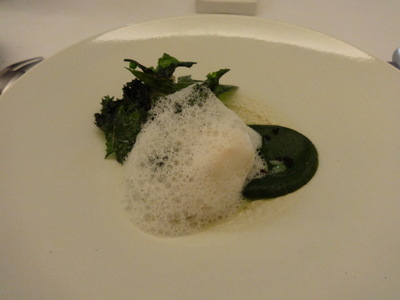 Next, we both chose the pressed foie gras with smoked eel. Where we say "surf and turf," the French say "terre et mer," but here the chef wrote "terre et estuaire." Again, pretty good, but I didn't think the eel contributed much. If it was supposed to look like something (a very straight rectangular eel, maybe?) I couldn't see it. One of the other choices for this course was onion soup "en trompe l'oeil"; I wondered what you could disguise onion soup as, but not enough to order it.
Next, we both chose the pressed foie gras with smoked eel. Where we say "surf and turf," the French say "terre et mer," but here the chef wrote "terre et estuaire." Again, pretty good, but I didn't think the eel contributed much. If it was supposed to look like something (a very straight rectangular eel, maybe?) I couldn't see it. One of the other choices for this course was onion soup "en trompe l'oeil"; I wondered what you could disguise onion soup as, but not enough to order it.
Next, for the fish course, I chose St. Pierre (Zeus faber, a fish) "green label" (just like that, in English; I assume it's a sustainability label of some sort). Served with a very green spinach and parsley purée (described by the waiter as "a chlorophyll") and some fried Swiss chard leaves.
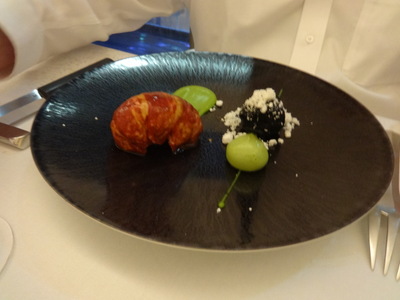
 David's fish was "lobster miso," which came with an agar-bound sphere of green stuff and a smear of other green stuff on the plate; both mildly wasabi-flavored, I think. The black timbale was maybe rice?
David's fish was "lobster miso," which came with an agar-bound sphere of green stuff and a smear of other green stuff on the plate; both mildly wasabi-flavored, I think. The black timbale was maybe rice?
Neither of us was curious enough to order the mackerel "in camouflage."
My meat course was lamb with asparagus and morels "from head to tail." On the main plate one cut of lamb was rolled up inside another. The green things are slices of a cylinder of pureed asparagus bound with thin slices of asparagus. I guess the morels must have been the little black minced up things inside the lamb roll.

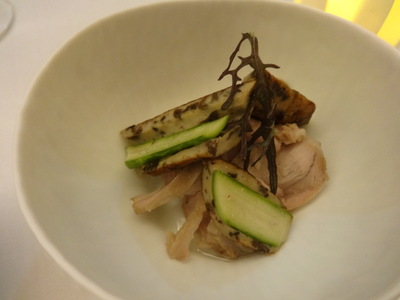 On the side were two other dishes, each containing a different part of the lamb and a different treatment asparagus. One seemed to be lamb bacon with diced asparagus and morels (I confess I don't remember what the large white thing was). The other was sliced leg with sliced asparagus and a little slice of asparagus and morel quiche.
On the side were two other dishes, each containing a different part of the lamb and a different treatment asparagus. One seemed to be lamb bacon with diced asparagus and morels (I confess I don't remember what the large white thing was). The other was sliced leg with sliced asparagus and a little slice of asparagus and morel quiche.
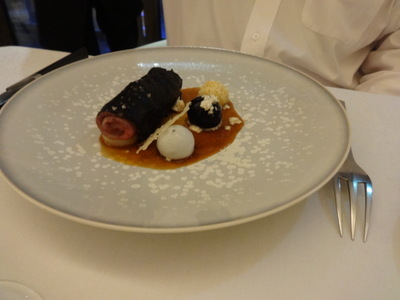
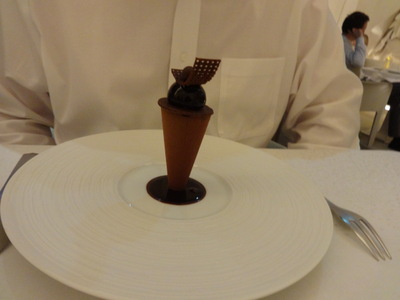 David's meat course was "boeuf charbon de Miyazaki," and he didn't know what to make of it. "Charbon" is "carbon or "coal," so presumably the black coating on the beef and the black coloring in one of the agar bound spheres is carbon. He said he couldn't even tell whether the beef was raw or cooked. It looked like a very thin raw slice tightly rolled up.
David's meat course was "boeuf charbon de Miyazaki," and he didn't know what to make of it. "Charbon" is "carbon or "coal," so presumably the black coating on the beef and the black coloring in one of the agar bound spheres is carbon. He said he couldn't even tell whether the beef was raw or cooked. It looked like a very thin raw slice tightly rolled up.
Neither of us ordered the "conical quail," but the guy at the next table did. It seemed to be a quail that had been cut up and stuffed tightly into a conical mold before roasting, coming out about the shape of the water bottle, though somewhat smaller.
David's dessert was "chocolated elegance with coconut," and so far as I can tell it wasn't supposed to look like anything else.

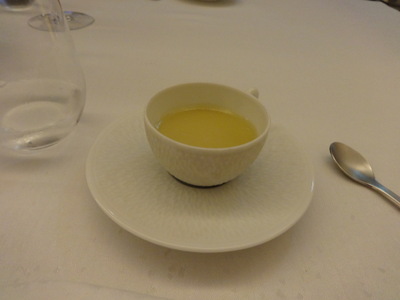 My dessert was a Granny Smith mousse with chervil. More like a cold Granny Smith soup, and it was really, really tart! It had diced Granny Smith apple in the bottom, as well as little cubes of apple jelly, and tiny crispy cookies, and Granny Smith sorbet peeking out at one edge of the plate. The shiny little apple on top, maybe an inch across, was made of sugar, blown like glass.
My dessert was a Granny Smith mousse with chervil. More like a cold Granny Smith soup, and it was really, really tart! It had diced Granny Smith apple in the bottom, as well as little cubes of apple jelly, and tiny crispy cookies, and Granny Smith sorbet peeking out at one edge of the plate. The shiny little apple on top, maybe an inch across, was made of sugar, blown like glass.
Next came a cup of "tea," actually a jelled custard.

 The mignardises continued the trompe l'oeil theme, being disguised as appetizers. The "sushi" are made of rice pudding (containing actual rice this time).
The mignardises continued the trompe l'oeil theme, being disguised as appetizers. The "sushi" are made of rice pudding (containing actual rice this time).
Certainly an interesting experience, but I don't think I'd go back.
Previous entry
List of Entries
Next entry

 David got up a little before lunch time, and we walked a block or two to the Franc Tireur for lunch. A "franc tireur" (literally "free shooter") is an independent person wo signs up to fight alongside the regular army without actually enlisting in it. Apparently, lots of them took part in the Franco-Prussian war.
David got up a little before lunch time, and we walked a block or two to the Franc Tireur for lunch. A "franc tireur" (literally "free shooter") is an independent person wo signs up to fight alongside the regular army without actually enlisting in it. Apparently, lots of them took part in the Franco-Prussian war. 
 It was late enough that we could order lunch. David got the salad with raw ham, potatoes (boiled, halved lengthwise, and browned on the cut side on the grill), hard-cooked egg, and Laguiole cheese (from the Aubrac region, of course). Yes, that's the same Laguiole that gives its name to the famous brand of knives marked with a bee on the handle. That's really good cheese—I'll have to watch out for it in the US.
It was late enough that we could order lunch. David got the salad with raw ham, potatoes (boiled, halved lengthwise, and browned on the cut side on the grill), hard-cooked egg, and Laguiole cheese (from the Aubrac region, of course). Yes, that's the same Laguiole that gives its name to the famous brand of knives marked with a bee on the handle. That's really good cheese—I'll have to watch out for it in the US.
 The Bastille Opera house celebrated its 30th anniversary this month. It was built as a replacement for and improvement on the old red-plush-and-gold-leaf "Palais Garnier" opera house in the center of the city, and as such it has been a huge success. Performers and production staff alike love it—it's clean, modern, convenient, well appointed, well thought out, self-contained, and above all big enough. It is, in fact, huge. Nearly a thousand people work there.
The Bastille Opera house celebrated its 30th anniversary this month. It was built as a replacement for and improvement on the old red-plush-and-gold-leaf "Palais Garnier" opera house in the center of the city, and as such it has been a huge success. Performers and production staff alike love it—it's clean, modern, convenient, well appointed, well thought out, self-contained, and above all big enough. It is, in fact, huge. Nearly a thousand people work there.
 Our tour started on floor –6, looking down into floor –7, all far below street level, and worked its way up gradually through the building to at least the 5th floor above ground. Fortunately, there are escalators, even backstage.
Our tour started on floor –6, looking down into floor –7, all far below street level, and worked its way up gradually through the building to at least the 5th floor above ground. Fortunately, there are escalators, even backstage.
 Scenery is moved around back stage on "chariots" (not as martial as it sounds; shopping carts are also "chariots"), sliding flatbed affairs that run on rails set into the floor. Eight or nine of them linked together just fit the stage. At the left you can see the rails the black chariot rides on. They form a right-angled grid so that the chariots can change direction, and a giant turntable in the center of the backstage area works like a railyard roundhouse to allow them to rotate. An entire stage set can be set up on chariots backstage, and one person can move it, silently, from there onto the stage in 4 minutes.
Scenery is moved around back stage on "chariots" (not as martial as it sounds; shopping carts are also "chariots"), sliding flatbed affairs that run on rails set into the floor. Eight or nine of them linked together just fit the stage. At the left you can see the rails the black chariot rides on. They form a right-angled grid so that the chariots can change direction, and a giant turntable in the center of the backstage area works like a railyard roundhouse to allow them to rotate. An entire stage set can be set up on chariots backstage, and one person can move it, silently, from there onto the stage in 4 minutes.
 The Bastille Opera makes all its own sets, costumes, and scenery as well as those for the Opéra Garnier, which is now mainly dedicated to dance. It has 8000 square meters of scenery construction space, employing 120 people. The wood shop has table saws big enough to slice up a house.
The Bastille Opera makes all its own sets, costumes, and scenery as well as those for the Opéra Garnier, which is now mainly dedicated to dance. It has 8000 square meters of scenery construction space, employing 120 people. The wood shop has table saws big enough to slice up a house.
 The area in which the tables were arranged was entirely upholstered in padded canvas, which had, in some spots, been artfully pulled out as though it were coming loose. You can see it in the photo at the left. The gray area behind David's head is the glass of the atrium, fogged up with the rain. The glowing object on the table is our tea light, which I think was intended to evoke the flapping-canvas theme of the banquettes.
The area in which the tables were arranged was entirely upholstered in padded canvas, which had, in some spots, been artfully pulled out as though it were coming loose. You can see it in the photo at the left. The gray area behind David's head is the glass of the atrium, fogged up with the rain. The glowing object on the table is our tea light, which I think was intended to evoke the flapping-canvas theme of the banquettes.
 We ordered the six-course tasting menu, which we got to choose from the items on the rather short menu. The chef, it turns out, is fond of trompe l'oeil. At the left is our amuse-bouche, designed to resemble mignardises. The triangle of "cake" with red filling is actually a sandwich of rhubarb between slices of cauiflower "bread"; the tartlet is mashed potato with panko sprinkled on top; the "lemon tart" is yellow and white polenta with hazelnuts; and the tall cup holds leeks vinaigrette with a little shedded wheat on top. In the bowl was (I think) a salad of Swiss chard stems with a little disk of daikon and sesame seeds.
We ordered the six-course tasting menu, which we got to choose from the items on the rather short menu. The chef, it turns out, is fond of trompe l'oeil. At the left is our amuse-bouche, designed to resemble mignardises. The triangle of "cake" with red filling is actually a sandwich of rhubarb between slices of cauiflower "bread"; the tartlet is mashed potato with panko sprinkled on top; the "lemon tart" is yellow and white polenta with hazelnuts; and the tall cup holds leeks vinaigrette with a little shedded wheat on top. In the bowl was (I think) a salad of Swiss chard stems with a little disk of daikon and sesame seeds.
 Next, we both chose the pressed foie gras with smoked eel. Where we say "surf and turf," the French say "terre et mer," but here the chef wrote "terre et estuaire." Again, pretty good, but I didn't think the eel contributed much. If it was supposed to look like something (a very straight rectangular eel, maybe?) I couldn't see it. One of the other choices for this course was onion soup "en trompe l'oeil"; I wondered what you could disguise onion soup as, but not enough to order it.
Next, we both chose the pressed foie gras with smoked eel. Where we say "surf and turf," the French say "terre et mer," but here the chef wrote "terre et estuaire." Again, pretty good, but I didn't think the eel contributed much. If it was supposed to look like something (a very straight rectangular eel, maybe?) I couldn't see it. One of the other choices for this course was onion soup "en trompe l'oeil"; I wondered what you could disguise onion soup as, but not enough to order it.
 David's fish was "lobster miso," which came with an agar-bound sphere of green stuff and a smear of other green stuff on the plate; both mildly wasabi-flavored, I think. The black timbale was maybe rice?
David's fish was "lobster miso," which came with an agar-bound sphere of green stuff and a smear of other green stuff on the plate; both mildly wasabi-flavored, I think. The black timbale was maybe rice?
 On the side were two other dishes, each containing a different part of the lamb and a different treatment asparagus. One seemed to be lamb bacon with diced asparagus and morels (I confess I don't remember what the large white thing was). The other was sliced leg with sliced asparagus and a little slice of asparagus and morel quiche.
On the side were two other dishes, each containing a different part of the lamb and a different treatment asparagus. One seemed to be lamb bacon with diced asparagus and morels (I confess I don't remember what the large white thing was). The other was sliced leg with sliced asparagus and a little slice of asparagus and morel quiche.
 David's meat course was "boeuf charbon de Miyazaki," and he didn't know what to make of it. "Charbon" is "carbon or "coal," so presumably the black coating on the beef and the black coloring in one of the agar bound spheres is carbon. He said he couldn't even tell whether the beef was raw or cooked. It looked like a very thin raw slice tightly rolled up.
David's meat course was "boeuf charbon de Miyazaki," and he didn't know what to make of it. "Charbon" is "carbon or "coal," so presumably the black coating on the beef and the black coloring in one of the agar bound spheres is carbon. He said he couldn't even tell whether the beef was raw or cooked. It looked like a very thin raw slice tightly rolled up.
 My dessert was a Granny Smith mousse with chervil. More like a cold Granny Smith soup, and it was really, really tart! It had diced Granny Smith apple in the bottom, as well as little cubes of apple jelly, and tiny crispy cookies, and Granny Smith sorbet peeking out at one edge of the plate. The shiny little apple on top, maybe an inch across, was made of sugar, blown like glass.
My dessert was a Granny Smith mousse with chervil. More like a cold Granny Smith soup, and it was really, really tart! It had diced Granny Smith apple in the bottom, as well as little cubes of apple jelly, and tiny crispy cookies, and Granny Smith sorbet peeking out at one edge of the plate. The shiny little apple on top, maybe an inch across, was made of sugar, blown like glass.
 The mignardises continued the trompe l'oeil theme, being disguised as appetizers. The "sushi" are made of rice pudding (containing actual rice this time).
The mignardises continued the trompe l'oeil theme, being disguised as appetizers. The "sushi" are made of rice pudding (containing actual rice this time).